Do you want to trade your winter boots for flip-flops? While most folks bundle up against winter’s chill, some of America’s most incredible national parks are basking in perfect temperatures.
I’m sometimes asked if you can visit national parks during winter?
Yes, absolutely! I love taking a winter national parks trip to these sun-soaked destinations. There’s nothing better than hitting the trail in a t-shirt while your friends back home are shoveling snow!
These parks aren’t just warm – they’re actually at their best during the winter months, with smaller crowds, clearer skies, and more active wildlife.
🛏️FIND A HOTEL: Search now
🚘FIND THE CHEAPEST CAR RENTAL: Search Discover Cars for the best deals
✈️FIND THE CHEAPEST FLIGHTS: Search Skyscanner for the best deals
🧳GET TRAVEL INSURANCE: Get insured with Travelex before you go
📱TAKE AN AUDIO TOUR: Buy an audio tour now
No time right now to read about the best national parks in the winter? Pin It and save it for later:
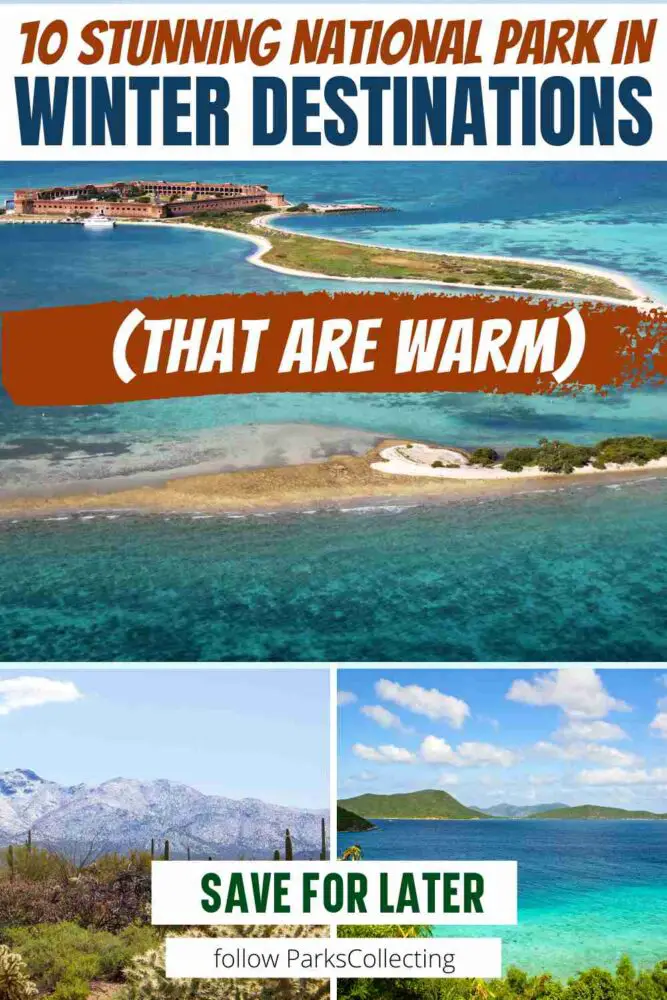
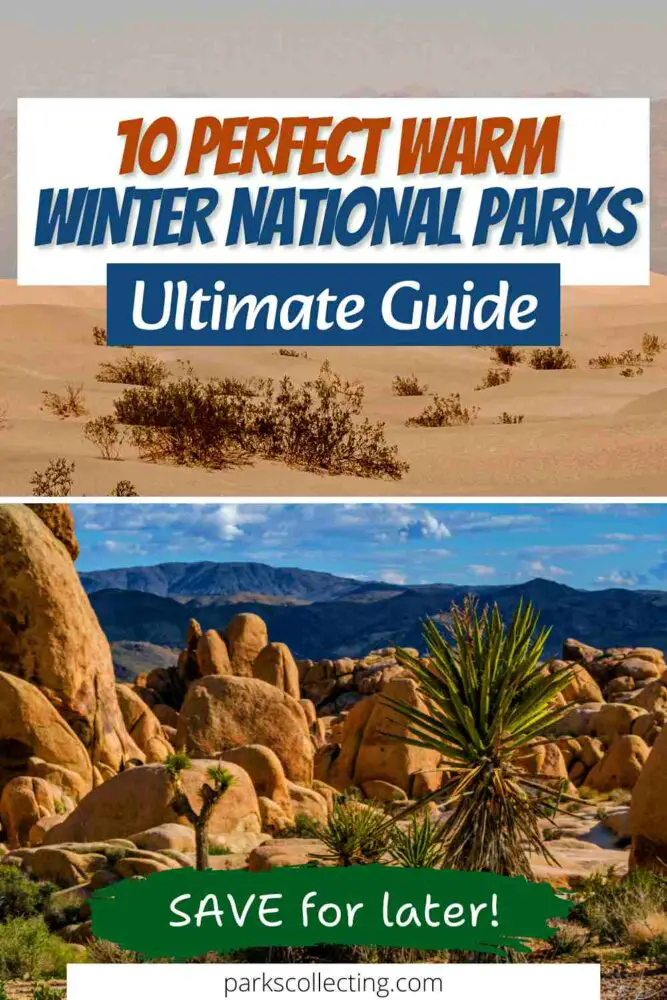
Subscribe to daily national parks planning tips, travel inspiration and trip ideas and I’ll send you a free PDF of this Guide:
10 Best National Parks to Visit in Winter (That Are Warm)
These are the best winter national parks to chase the sun …
Table of Contents
1. Everglades National Park, FL
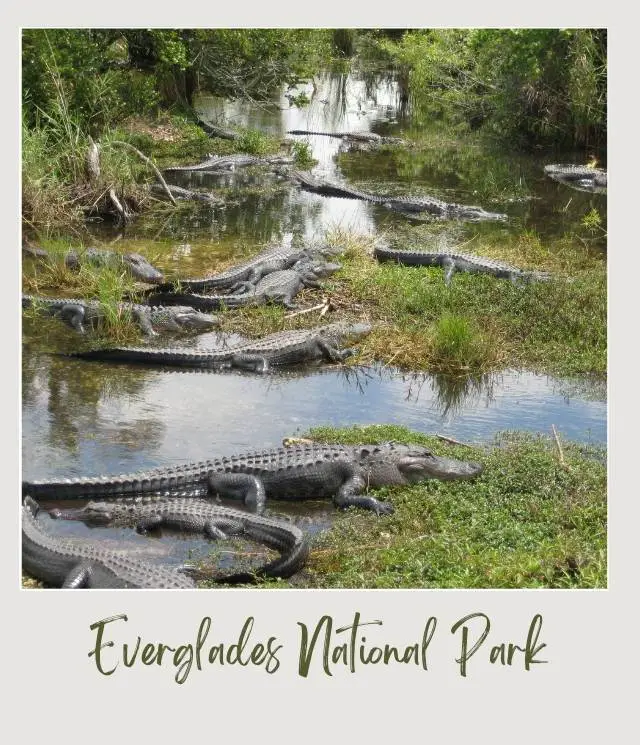
In winter, the Everglades comes alive with perfect 70-degree days and low humidity. December through March is when the park really shines – you’ll catch sight of more birds, alligators, and other wildlife than any other time of year.
The dry season also means fewer mosquitos and easier hiking on trails like Anhinga and Gumbo Limbo. I love hitting the boardwalks early in the morning when the mist rises off the water and birds are most active. Rangers offer more guided walks and talks during these months too, giving you the inside scoop on the park’s incredible ecosystem.
For the best wildlife viewing, hop on an airboat tour through the sawgrass marshes. The cooler temps bring animals out in the open – you might spot manatees huddling in warm water spots or flocks of roseate spoonbills feeding in shallow pools.
‼️ PRO TIP: Want to get even closer to nature? Rent a canoe and paddle the marked water trails. Winter’s calm waters make it perfect for beginners, and you’ll get amazing photos of wading birds against the golden afternoon light.
2. Death Valley National Park, CA
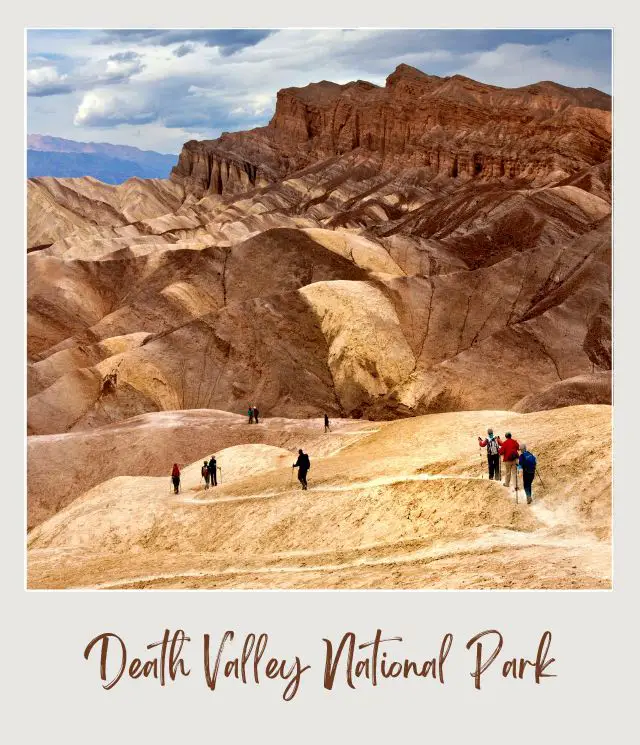
Winter in Death Valley brings the most comfortable hiking temperatures of the year, with days in the 60s and clear blue skies. It’s a total flip from summer when temps can hit 120°F!
The cooler winter weather opens up so many trails and viewpoints that would be too hot to handle in peak season conditions.
I love heading to Zabriskie Point at sunrise to watch the golden light hit the rippled badlands. The morning chill burns off quickly, making it perfect for a morning hike through Golden Canyon or a walk on the salt flats at Badwater Basin – the lowest point in North America.
The dark winter skies make Death Valley one of the best winter destinations for stargazing. Head to the Harmony Borax Works after sunset – the lack of light pollution means you’ll see more stars than you can count. The Milky Way stretches across the sky like a river of light.
PRO TIPS:
‼️ Keep in mind that nights can get cold, often dropping into the 40s. Pack warm layers because the temperature swing between day and night can be 30-40 degrees.
‼️ The park has great camping options, including full hookup sites if you’re bringing an RV.
➡️ Read More: Death Valley National Park Travel Guide
3. Joshua Tree National Park, CA
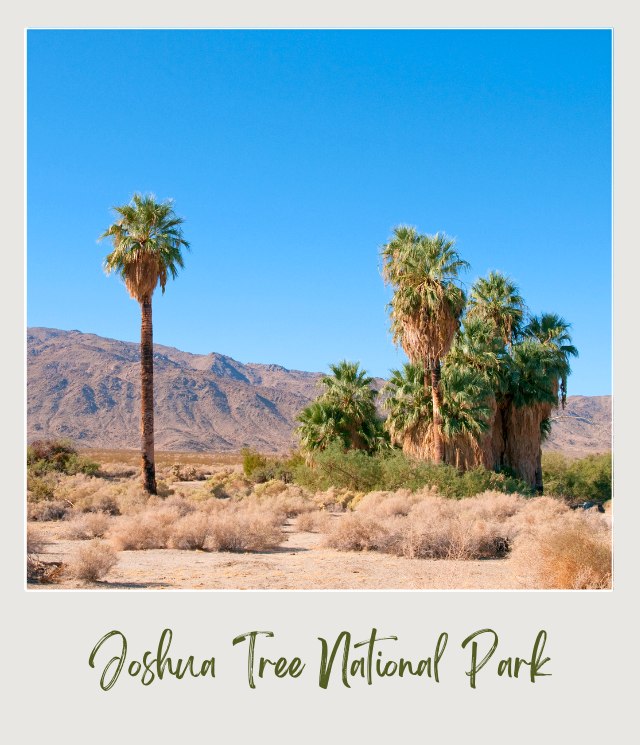
Winter brings perfect conditions to Joshua Tree, with sunny days in the 60s and 70s. The mild temperatures make it ideal for rock climbing and hiking through the park’s otherworldly landscape of twisted trees and massive boulder formations.
Hidden Valley Trail offers an easy one-mile loop that winds through a rock-enclosed valley. Local legend says cattle rustlers once hid their stolen herds here. Today, it’s a favorite spot for climbers of all skill levels, with over 8,000 climbing routes throughout the park.
Ryan Mountain Trail gives you a workout with a three-mile round trip climb to amazing desert views. On clear winter days, you can see all the way to San Gorgonio Mountain and the Salton Sea. Start early to catch the sunrise lighting up the desert floor.
Nights get chilly, often dropping into the 40s, but that makes for incredible stargazing. The park’s dark sky status means you’ll see constellations you never knew existed. Book a campsite at Jumbo Rocks or Hidden Valley – nothing beats waking up surrounded by those iconic Joshua trees silhouetted against the morning sky.
‼️ PRO TIP: Remember to pack lots of water even in winter – the desert air is super dry. And grab a map at the visitor center since cell service can be spotty in the park.
➡️ Read More: Joshua Tree National Park Guide
4. Saguaro National Park, TX
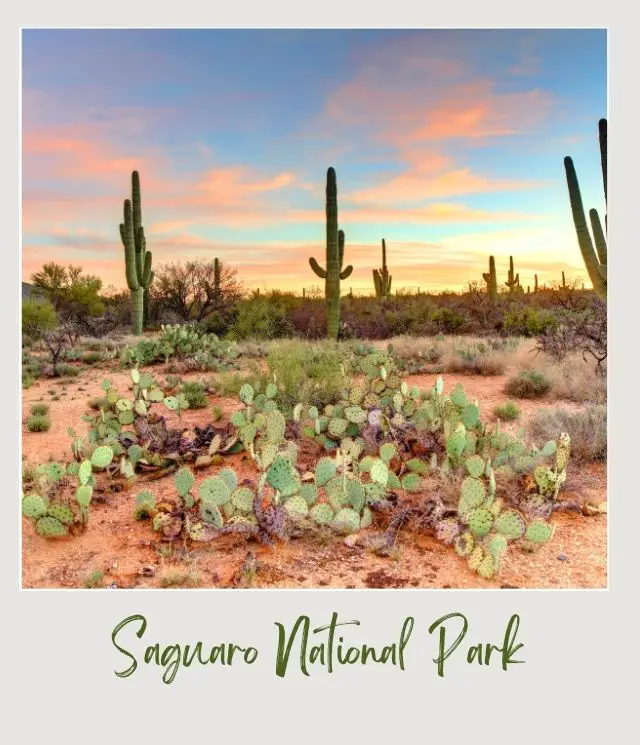
Winter in Saguaro gives you front-row seats to some of Arizona’s best weather. The temperatures stay in the 60s and 70s during the day – perfect for hitting the trails without melting in the sun. The park’s massive saguaro cacti stand like silent giants against bright blue winter skies.
The Valley View Overlook Trail is an easy one-mile walk that shows off the best of both park districts. Go at sunset when the low light makes the cacti glow and turns the Tucson Mountains gold. You might spot coyotes or roadrunners heading out for their evening hunt.
King Canyon Trail offers a more challenging hike to Wasson Peak, the highest point in the Tucson Mountain District. The winter views stretch forever, and you won’t have to worry about summer thunderstorms. Start early – even winter days warm up fast in the desert.
Don’t miss the Desert Discovery Trail in the eastern district. This paved path lets you get up close with different desert plants while staying on flat ground. Rangers often lead morning walks here, sharing cool facts about how plants and animals survive in the desert.
‼️ PRO TIP: Pack plenty of water and sunscreen – the winter sun still packs a punch in the desert. The visitor centers have great maps and updates on which trails have wildflowers starting to bloom.
5. Big Bend National Park, TX
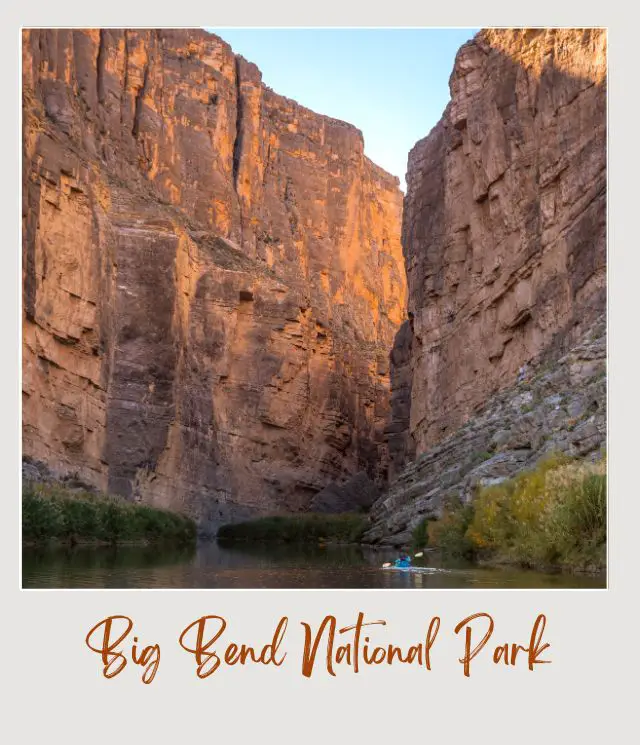
Big Bend hits its stride in winter with perfect weather in the 70s and low 80s. The Chisos Mountains tower over desert plains, creating a mix of landscapes you won’t find anywhere else in Texas. Winter brings crystal clear skies – perfect for hitting the trails or exploring nearby attractions.
The Window Trail leads you through oak and pine forests to a V-shaped canyon with killer sunset views. Lost Mine Trail climbs through the mountains for 360-degree views of both Texas and Mexico. In winter, you won’t have to dodge the brutal summer heat that can top 100°F.
Santa Elena Canyon is a must-see. The Rio Grande cuts between 1,500-foot limestone cliffs, and winter’s stable water levels make it great for kayaking.
The hot springs near Rio Grande Village stay warm year-round – nothing beats soaking in 105°F water while watching the sunset paint the desert hills.
‼️ PRO TIP: Getting here takes some planning – El Paso’s the closest major airport, about 4 hours away. Book a spot at the Chisos Mountains Lodge or grab a campsite – you’ll want to catch those amazing winter sunrises. The dark skies make Big Bend one of the best spots in the US for stargazing.
6. Dry Tortugas National Park, FL
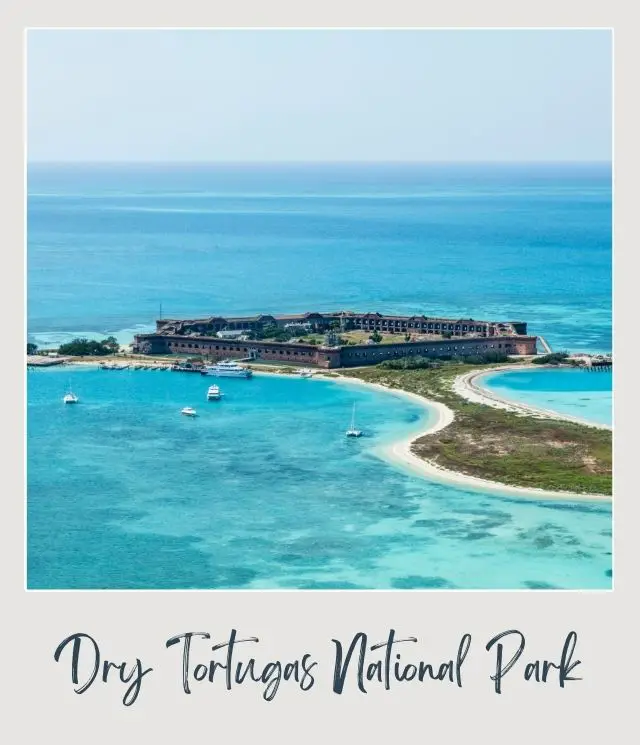
Hop on a seaplane or boat from Key West, and you’ll land at one of Florida’s most remote and best national parks for winter exploring.
Winter brings the calmest seas and clearest conditions to Dry Tortugas, making it perfect for snorkeling the coral reefs or wandering through massive Fort Jefferson.
The winter water stays warm enough for swimming and snorkeling – usually in the mid-70s. The reefs around the fort teem with tropical fish, and the visibility often stretches to 100 feet. Garden Key has the best beginner-friendly snorkeling spots, right off the beach near the fort’s moat wall.
Bird watchers hit the jackpot in winter. The park sits on the migration path for tons of species heading south. Bush Key fills up with sooty terns and brown noddies, while frigatebirds glide overhead with their distinctive forked tails.
‼️ PRO TIP: Book your trip well ahead – the ferry and seaplane spots fill up fast in winter.
‼️ PRO TIP: If you’re camping (and you should), pack everything you need. There’s no store on the island, and the only fresh water comes from what you bring or collect from rain tanks.
7. Channel Islands National Park, CA
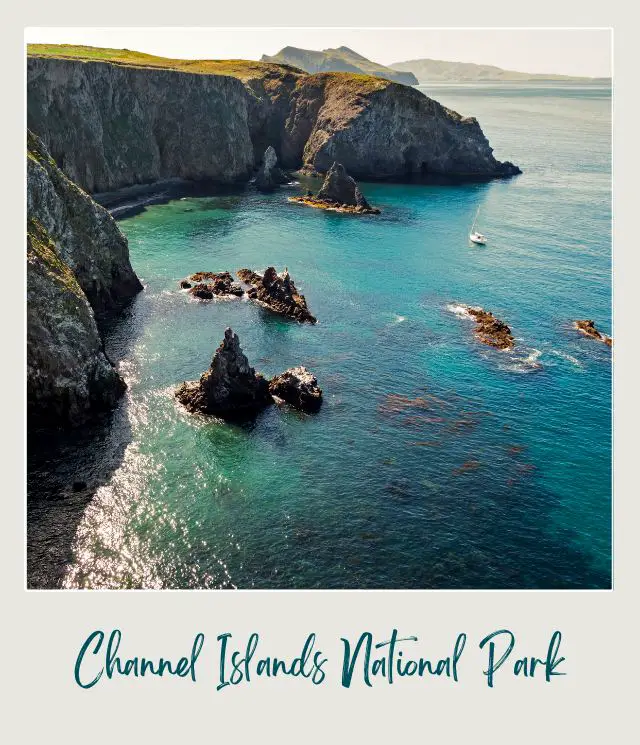
Off California’s coast, Channel Islands National Park offers a totally different kind of winter escape. The islands stay mild year-round, with temps in the 60s making it perfect for hiking and kayaking without the summer crowds.
Winter brings the best whale watching of the year. Gray whales pass by during their migration, and you might spot massive blue whales too. The clear winter air gives you amazing views of these giants from the hiking trails above the coast.
Kayaking through the sea caves is easier in winter when the ocean’s typically calmer. The caves around Santa Cruz Island are like natural cathedrals – each one different from the last. Keep your eyes peeled for bright orange garibaldi fish darting through the kelp forests.
December through March is peak season for watching the island foxes. These little guys, found nowhere else on Earth, are more active in the cooler months. Take the Potato Harbor Trail on Santa Cruz Island for the best chance to spot them.
‼️ PRO TIP: Pack warm layers and rain gear – island weather changes fast. The ferry ride can be choppy, but the isolation makes you feel like you’ve found your own private California.
➡️ Read More: Channel Islands National Park Guide
8. Virgin Islands National Park, USVI
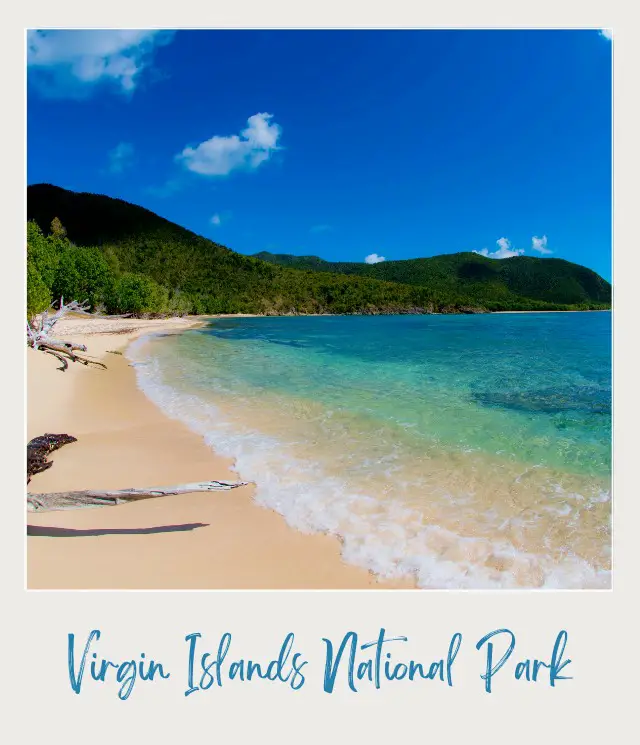
Winter in Virgin Islands National Park hits all the right notes – 80-degree days, white sand beaches, and water so blue it looks photoshopped. The park takes up most of St. John island, mixing pristine beaches with hiking trails through leafy forests.
Trunk Bay’s underwater snorkel trail lets you spot parrotfish and sea turtles in crystal clear water. The marked route has plaques explaining what you’re seeing – it’s like a museum under the waves. January and February bring the calmest seas and best visibility.
Reef Bay Trail winds through old sugar plantations to ancient petroglyphs. The downhill hike passes massive kapok trees and old stone ruins before ending at a quiet beach. Go early to beat the heat and catch hermit crabs scuttling across the trail.
The Annaberg Sugar Plantation ruins offer amazing north shore views while teaching you about the island’s history. Rangers often demonstrate traditional cooking and crafts here during winter months.
‼️ PRO TIP: Book your stay months ahead – winter’s high season on St. John. Cruz Bay has the most lodging options, but Salt Pond Bay’s campground puts you right by some of the best snorkeling spots.
‼️ PRO TIP: Pack reef-safe sunscreen and a hat – that Caribbean sun’s strong even in winter.
9. Biscayne National Park, FL
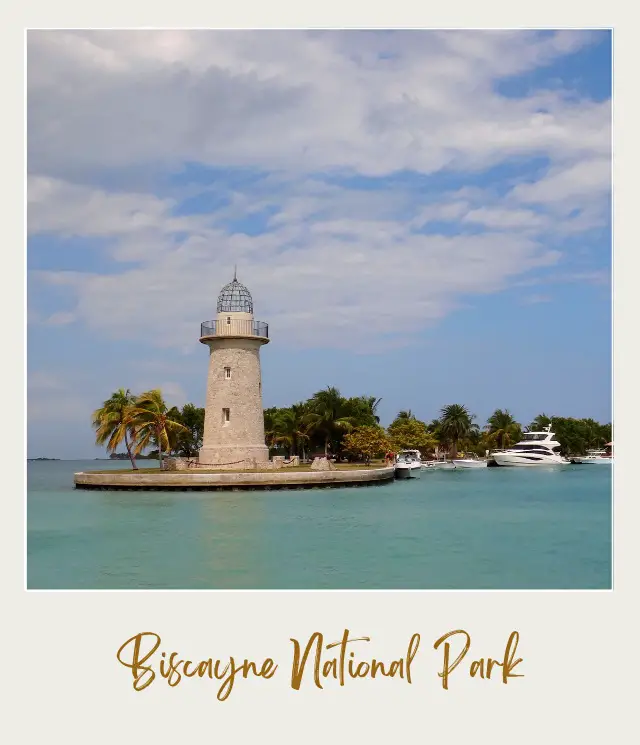
Winter brings the best conditions to Biscayne – the water’s crystal clear and the weather’s perfect in the 70s. The park’s coral reefs light up with tropical fish, and the gentle winter waves make it ideal for kayaking through the mangrove trails.
The Maritime Heritage Trail lets you snorkel above shipwrecks in shallow water. Winter’s calm seas mean better visibility – you’ll spot parrotfish, angelfish, and maybe even nurse sharks resting in the sand. The park’s glass-bottom boat tours give you a dry option for checking out the reefs.
Paddle the mangrove-lined Jones Lagoon in winter when mosquitoes are scarce. It’s like floating through a maze of twisted roots where you might spot manatees seeking warm water. Keep your eyes peeled for migrating birds perched in the trees – herons, egrets, and ibis love hanging out here.
Elliott Key has great winter camping – the temps are just right for sleeping under the stars.
‼️ PRO TIP: There’s no bridge to the islands, so you’ll need to boat or kayak out. Pack your snorkel gear and water shoes – the best spots are right off the beach. Miami’s just a short drive away, making it easy to mix city fun with island time.
10. Haleakalā National Park, HI
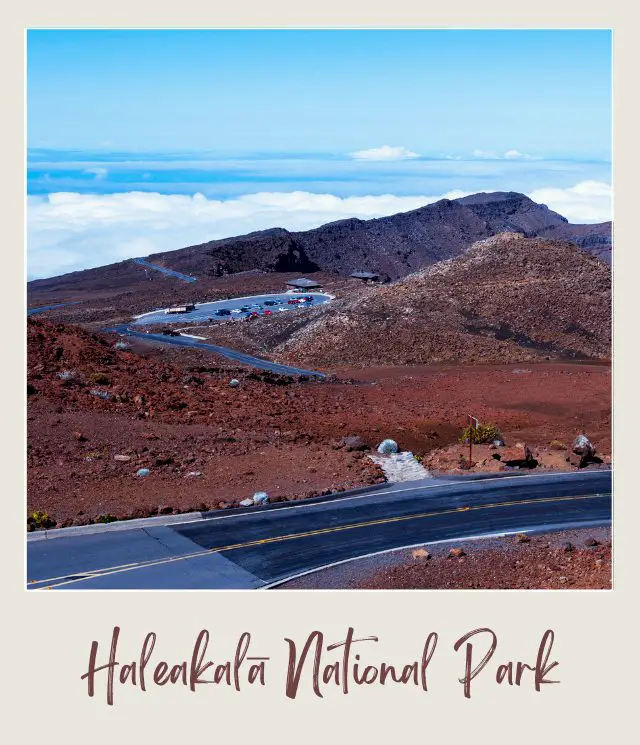
Winter at Haleakalā brings something really special – you can watch the sunrise from 10,000 feet while staying warm in the Hawaiian sun later that day. The park’s like nowhere else, stretching from beach level through rainforest and up to what looks like Mars at the summit.
⚠️ You need to get a permit to get to the summit for sunrise. Check details in my guide to the national parks that need reservations.
The Sliding Sands Trail drops you right into the crater floor. In winter, the morning light hits the red and orange cinder cones just right, making them glow against the blue sky. Start early – the weather’s best before noon, and you’ll beat any afternoon clouds that roll in.
Hosmer Grove lets you spot Hawaii’s native birds without hiking too far. The short loop trail winds through trees filled with bright red i’iwi and yellow amakihi. Winter brings more birds to the lower elevations where it’s warmer.
‼️ PRO TIP: Pack layers – it might be 75°F at sea level, but the summit can drop into the 40s. The clear winter skies make for amazing stargazing from the visitor center parking lot. Time your visit around the new moon for the best views of the Milky Way stretching over the crater.
‼️ PRO TIP: Grab a camping permit for Hosmer Grove or Kipahulu – winter nights are perfect for sleeping under the stars. Just keep an eye on the weather – winter storms can pop up fast on the mountain.
Your Winter Warm-Up Awaits
Trading snow for sunshine isn’t just about escaping winter – it’s about experiencing these incredible parks when they’re at their absolute best. The comfortable temperatures from December through March create perfect conditions for hiking, wildlife watching, and outdoor adventures that would be unbearable during the scorching summer months.
Pack your sunscreen and water bottle, and get ready to explore these winter-friendly parks. You’ll find yourself wondering why you ever waited for summer to plan your national park adventures.
The best part? While everyone else is hibernating, you’ll have some of America’s most stunning landscapes almost all to yourself.
Would you add any others to this list of the best national parks in winter? Join my private Facebook group National Parks Collectors and comment and let me know (you can also pick up extra planning tips, share your photos and stories with other national park lovers and more).
Subscribe to daily national parks planning tips, travel inspiration and trip ideas and I’ll send you a free PDF of this Guide:
10 Best National Parks to Visit in Winter (That Are Warm)
If you liked this article, Pin It to your National Parks board!


💡 Are you just starting to think about taking a National Parks trip? Get Inspiration
‼️ Do you need tips and additional information? Read a selection of tips for visiting US national parks
💻 Are you starting to plan a trip to a national park? Read my free guides
📋 Do you need an itinerary? Buy a detailed itinerary for your park
💲 Are you ready to book your trip? Use these Planning and Booking Resources
📖 Do you want to read a book about US national parks? Check out my Recommended Reading Lists
About the Author
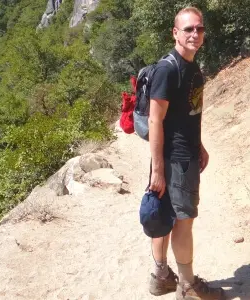
James Ian is a national park, camping and hiking expert.
He has dedicated his life to travel, visiting more than 80 countries, all 7 continents and most of the national parks in the United States. With over 35 years experience in the travel industry, James has worked on cruise ships, at resorts and hotels, and as a travel planner who’s helped hundreds of people plan successful trips to US national parks.
Based on his experience visiting our national parks multiple times, in-depth research and expertise as a travel planner, James has published detailed itineraries for many of the major national parks in the US. These itineraries, as well as in-depth park guides, and other resources will help you have your own incredible trip to US national parks without stress and hassle.
As a national park expert, James has contributed to many publications, including USA Today, Newsweek, Time Business News, Savoteur, Best Trip, and Wired.
I’m a member of the Amazon Services LLC Associates Program. As an Amazon Associate I earn from qualifying purchases.
